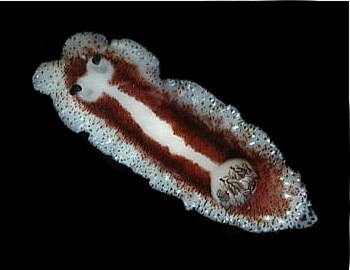
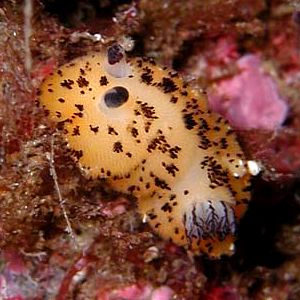
Jorunna parva?
(Baba, 1938)
Order: NUDIBRANCHIA
Suborder: DORIDINA
Superfamily: EUDORIDOIDEA
Family: Dorididae
PHOTO
UPPER: 30mm long, 1m depth, at Miura Peninsula, Japan. Photo: Satoru Hori.
LOWER: Echizen Beach, Japan, 5m, 12 Aug 2001. Length: 15mm. Photo: Nishina Masayoshi
It is possible that these two animals are extreme colour forms of the same species. See Satoru Hori's message and Nishina Masayoshi's message below.
Compare also with Jorunna pardus and Jorunna sp. 2.
References:
• Baba, K. (1938) Opisthobranchia of Kii, Middle Japan. Journal of the Dept of Agriculture, Kyushu Imperial University, 6(1): 1-19.
• Baba, K. (1949) Opisthobranchia of Sagami Bay. Iwanami Shoten: Tokyo
Rudman, W.B., 2000 (July 4) Jorunna parva? (Baba, 1938). [In] Sea Slug Forum. Australian Museum, Sydney. Available from http://www.seaslugforum.net/find/joruparv
Related messages
Re: Jorunna parva from nthn Mariana Islands
October 3, 2008
From: Yuji Fujie
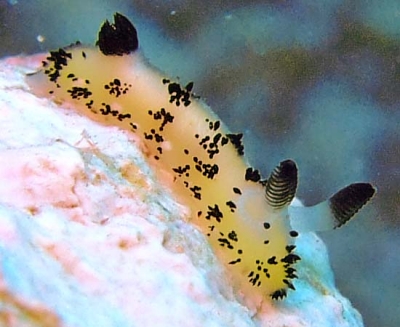
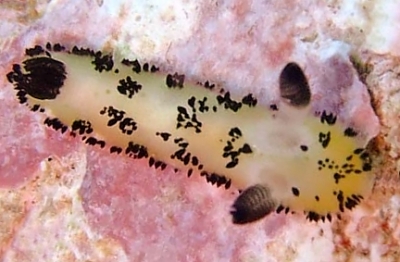
Concerning message #21618:
Dear Dr.Bill,
Here are three photos we thought were Jorunna parva. The water temperature of a Saipan island is high maybe 28 - 30 degree C but, Ms.Teresa Zuberbühler said, "perhaps they prefer colder water" in her message. In fact I don't know anything about it because' I saw this animal first time in Saipan.
Locality: LauLau Beach, 8m, Saipan, Northern Mariana Islands, Pacific Ocean, 15 September 2008, under the dead coral with red sponge. Length: 10mm. Photographer: Yuji Fujie.
Would you tell us your opinion, please ?
Best regards,
Yuji
ds-with@isletwind.com
Yuji Fujie, 2008 (Oct 3) Re: Jorunna parva from nthn Mariana Islands. [Message in] Sea Slug Forum. Australian Museum, Sydney. Available from http://www.seaslugforum.net/find/21901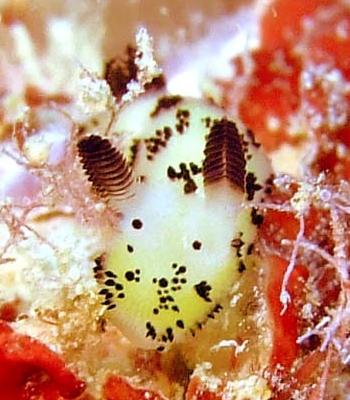
Dear Yuji,
Yes I agree your animal is the one I have been calling Jorunna parva, and I suspect it is the same as Jorunna sp. 2 which would give it a very wide distribution in the tropical to warm temperate Indo-West Pacific.
Best wishes,
Bill Rudman
Re: Jorunna parva from Japan
July 14, 2008
From: Teresa Zuberbühler
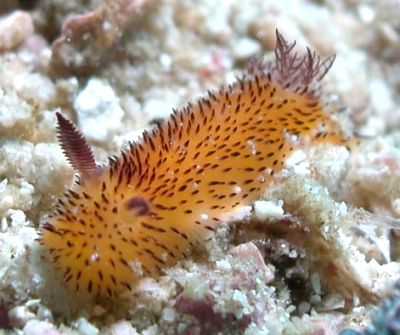
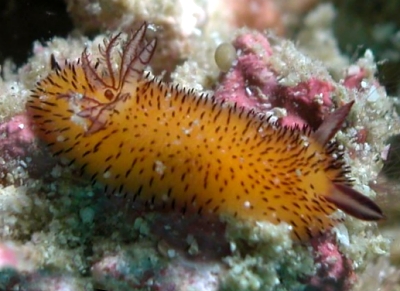
Concerning message #5269:
Dear Bill
I have seen this type of Jorunna parva also in the Komodo Islands, Indonesia. The water temperature there is quite low, perhaps they prefer colder water like in Japan.
Locality: Komodo islands, 15-20m, Indonesia, Pacific, 25. July 2005, coarse white sand / cold water. Length: less than 2cm. Photographer: Teresa (Zubi) Zuberbühler.
The small Jorunna parva was crawling around quite quickly.
I hope this sighting helps you to determine whether this species is widespread or not.
Greetings from Switzerland
Teresa
www.starfish.ch
webmaster@starfish.ch
Zuberbühler, T., 2008 (Jul 14) Re: Jorunna parva from Japan. [Message in] Sea Slug Forum. Australian Museum, Sydney. Available from http://www.seaslugforum.net/find/21618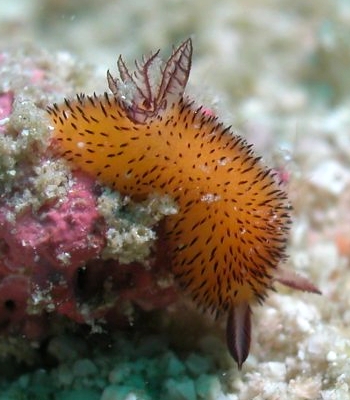
Thanks Teresa,
Best wishes,
Bill Rudman
Jorunna parva? from Japan
November 15, 2003
From: Yukari Sato
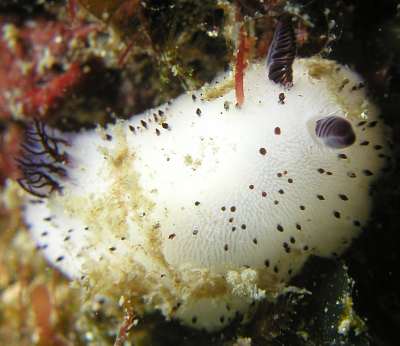
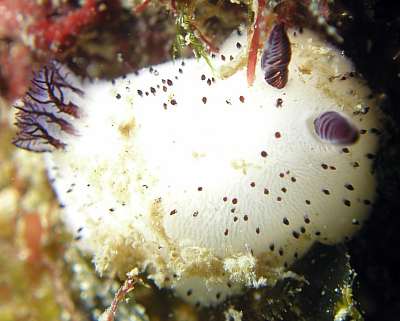
Hello Dr.Rudman,
I have found this animal at Izu, Japan. I suspect this is maybe Jorunna parva. Could you confirm this?
Date: 21 May 2003
Depth: 20m
Size: approx.12mm-15mm
Location: Tago, Suruga bay, west coast of Izu peninsula, Japan
Best regards,
Yukari Sato
yuks@cg7.so-net.ne.jp
Sato, Y., 2003 (Nov 15) Jorunna parva? from Japan. [Message in] Sea Slug Forum. Australian Museum, Sydney. Available from http://www.seaslugforum.net/find/11367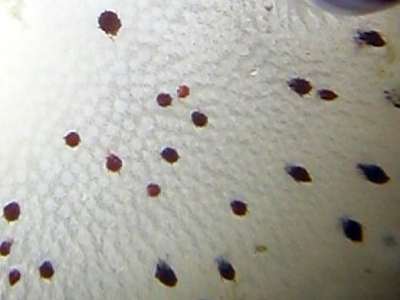
Dear Yukari,
This could quite possibly be a pale form of J. parva but as I have discussed elsewhere, it is possible that Jorunna sp. 2 is the same species and there are colour forms on that page which match your animal identically. We still have a lot to learn about this group of species before we can be sure of their identity
Best wishes
Bill Rudman
Re Jorunna parva from Japan
September 15, 2001
From: Jun Imamoto
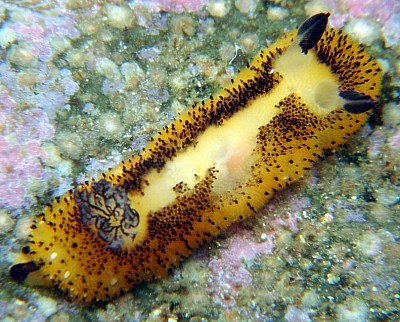
I am sending this photo because it is of a different individual than the one in Mr. Nishina's message. I took the pictures of it at the same place as Mr. Nishina.
It was a little bit bigger.
Date: 12 Aug 2001
Place: Echizen coast(Tsuruga-bay, Japan)
Depth: 4-5m
Size: about 20-25mm
Water temperature: 27-28C degrees.
Jun Imamoto
imamoto@wips.co.jp
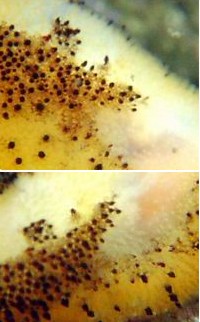
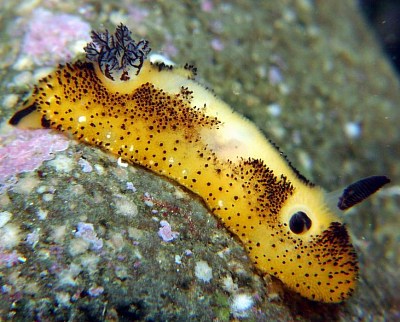
Dear Jun,
Thank you for these interesting photos. It is a strange colour pattern. It almost appears that the animal has been damaged.
Best wishes,
Bill Rudman
Thordisa parva and Jorunna parva
September 10, 2001
From: Nishina Masayoshi
Dear Dr.Rudman,
I think Thordisa parva Baba description and Jorunna parva are the same because both are called "Gomafubiroudoumiushi" in Japanese. I am not sure but I suspect that an animal with white body with scattered black caryophyllidia is also J. parva [see the white animal - Page 107 in Keiu Suzuki's book]. They are similar but the color of the rhinophores and gills are bit different.
rather say, it's a purple-red.
Best Regards,
Nishina Masayoshi
nishina@hpe15.wips.co.jp
Nishina, M., 2001 (Sep 10) Thordisa parva and Jorunna parva. [Message in] Sea Slug Forum. Australian Museum, Sydney. Available from http://www.seaslugforum.net/find/5239Dear Nishina,
I should have explained that Thordisa parva and Jorunna parva are the same. Dr Baba originally decided the species belonged in the genus Thordisa but it is now considered to be a Jorunna. I used the name 'Thordisa parva' in my message just to show I was talking about Baba's first description.
The reason I think they are probably all the same is that I have found a very similar range in colour variation here in eastern Australia in what I now think is the same species. It is in the Forum as Jorunna sp. 2.
Best wishes,
Bill Rudman
Jorunna parva and J. pardus
September 10, 2001
From: Nishina Masayoshi
Dear Dr.Rudman,
I've got a email from David W. Behrens(author of Pacific Coast Nudibranchs). He suspects that Jorunna parva looks identical to the Californian species - Jorunna pardus Behrens and Henderson 1981. I was wondering too, as they are very similar to each other.
So I checked Baba's description in Opisthobranchs of Sagami Bay and in Abe's Opisthobranchs of Toyama Bay and other photos. Baba mentioned that radula formula is 12 x 18.0.18 and it has about 11 gills (Opis. of Sagami Bay) to 14 gills (Opis. of Toyama bay). The gills are described as: "gill has a black (Opis. of Sagami bay) or black-purple (Opis. of Toyama Bay) brown line along the branchical veins". If body color is white, those feature are the same.
And your comment "It is possible that these two animals (my animal and Satoru Hori's) are extreme colour forms of the same species" is understandable. Because there are no caryophyllidia on the middle of its back in all J. parva that I can see here.
And length is different, David W. Behrens mentioned "Living animals measure up to 60mm" but I've never heard such a big J. parva. Average length of J. parva is 10mm to 20mm in Japan. So I think those are different animal. Anyhow if we could here from David W. Behrens on the number of gills and caryophyllidia pattern that he's ever seen, it will be helpful for this puzzle.
Here is another puzzle left. In Atsushi Ono's book there is a yellow animal with scattered black
papillae (p.113) which he identifies as J. parva (Baba, 1938). There are caryophyllidia on the middle on its back. He wonders if his J. parva may not be J. parva or an intermediate form
because of the pattern of the caryophyllidia. In Opisthobranchs of Toyama Bay, Abe mentions also that there is a very similar animal which has extreme black caryophyllidia on the middle of its back, but he is not sure whether it is J. parva or not.
Best Regards,
Nishina Masayoshi
nishina@wips.co.jp
Nishina, M., 2001 (Sep 10) Jorunna parva and J. pardus. [Message in] Sea Slug Forum. Australian Museum, Sydney. Available from http://www.seaslugforum.net/find/5241Dear Nishina,
Thanks for your thoughts in this and your earlier message. I had also wondered about the Californian species. Both Behrens and Baba mention that the outermost teeth in their species have denticles. As you say though the much larger size that Californian animals grow to may be a problem, unless it is a result of living in colder waters.
Concerning the band down the centre of the mantle. This is not a band where caryophyllidia are absent as in species of Jorunna there is an even cover of caryophyllidia over the whole mantle. What is happening is that some of the caryophyllidia are black while the others are yellow or white - the background colour of the mantle. I mentioned the band in your yellow animal and Satoru Hori's white and brown animal to show they had similarities. It is not necessarily a unique character of the species. If you look at photos of South African specimens of Jorunna sp. 2 both Ernest Seamark's and Valda Fraser's photos show a clear region around the rhinophores and the gills which could be interpreted as the beginnings of the median band. Interestingly one of the South African animals shows the black caryophyllidia scattered individually while in the other they show signs of being clumped in small aggregations.
I suspect Jorunna parva will turn out to be a widespread Indo-West Pacific species with a variable colour pattern.
Bst wishes,
Bill Rudman
Jorunna parva f rom Japan
September 8, 2001
From: Nishina Masayoshi
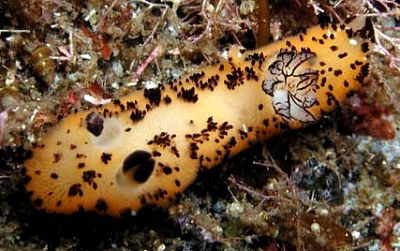

Dear Dr.Rudman,
Here are photos of Jorunna parva. However one of the rhinophores is not perfect.
Date: 12 Aug 2001
Location: Echizen beach, Japan
Depth: 5m
Length: 15mm
Frequency in Echizen: rare
Best Regards,
Nishina Masayoshi
nishina@hpe15.wips.co.jp
Nishina, M., 2001 (Sep 8) Jorunna parva f rom Japan. [Message in] Sea Slug Forum. Australian Museum, Sydney. Available from http://www.seaslugforum.net/find/5079Dear Nishina,
Thanks for these photos. This is certainly the animal I have been calling Jorunna sp. 2. As I discuss in Satoru Hori's message, it is a question of whether this is Baba's Thordisa parva. I have seen animals in Australia which match Baba's illustration very well, and as I illustrate on that page, Jorunna sp. 2 ranges from translucent white with scattered black caryophyllidia (the papillae on its back) to forms which are yellow with the black caryophyllidia clustered to form large black spots. Like your animals, there is large black spot on the posterior tip of the foot. It is interesting that both the animal in Satoru Hori's photo and yours have this broad band down the centre of the mantle which is devoid of black caryophyllidia.
It would be nice to find a specimen from Japan that fitted Baba's description a little better.
Best wishes,
Bill Rudman
Jorunna parva? from Japan
July 5, 2000
From: Satoru Hori

Dear Bill
This sea slug is 30mm long, found at 1m depth, at Miura peninshula, Japan.
I could not find any similar species in some Japanese sea slug books.
Would you identify this for me?
Satoru
http://www.asahi-net.or.jp/~IK8S-HR/umiushi.html
ik8s-hr@asahi-net.or.jp
Hori, S., 2000 (Jul 5) Jorunna parva? from Japan. [Message in] Sea Slug Forum. Australian Museum, Sydney. Available from http://www.seaslugforum.net/find/2654Dear Satoru,
I have never seen this colour form before but I suspect it is a species of Jorunna. It looks very similar to Thordisa parva Baba, 1938. There is a painting in Opisthobranchs of Sagami Bay (Baba, 1949, Plate 24 fig. 90) of an animal with brownish bands down each side of the mantle very much like in your photo but not as intense.
The original description of Thordisa parva is of a 6mm animal with 'grayish yellow' body and black stains here and there on dorsal papillae and edge of foot. The back is covered with caryophyllidia. In Atsushi Ono's recent book there is a yellow animal with scattered black
papillae (p.113) which he identifies as Jorunna parva (Baba, 1938). It looks like an intermediate between the yellow colour forms of Jorunna sp. 2, and has the large black patch at the posterior tip of the foot which is characteristic of Jorunna sp. 2.
What I am not sure of is whether the round black spot on the tip of the foot in Baba's original description of Thordisa parva, the similar black spot in the Sagami Bay painting, indicate that Jorunna parva is different from Jorunna sp. 2 or not. Your photo only shows a small part of the posterior foot but from that there seem to be a row of small black spots around the edge and a larger, partially hidden, black spot in the posterior midline.
All I can say is that your animal seems to be the same as the Thordisa parva in Opisthobranchs of Sagami Bay. If you have photos or notes on other similar species of Jorunna it would be interesting to compare them with the photos on the Forum of Jorunna sp. 2, and in particular, check how consistent the black spot is on the foot.
References:
• Baba, K. (1938) Opisthobranchia of Kii, Middle Japan. Journal of the Dept of Agriculture, Kyushu Imperial University, 6(1): 1-19.
• Baba, K. (1949) Opisthobranchia of Sagami Bay. Iwanami Shoten: Tokyo
Best wishes,
Bill Rudman.
